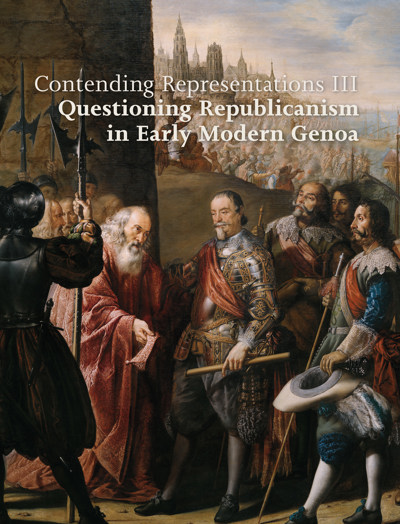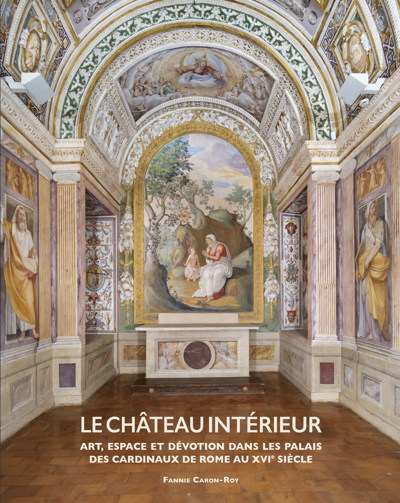
Contending Representations III
Questioning Republicanism in Early Modern Genoa
Enrico Zucchi, Alessandro Metlica (eds)
- Pages: 196 p.
- Size:216 x 280 mm
- Illustrations:2 b/w, 63 col., 5 tables b/w.
- Language(s):English
- Publication Year:2024
- € 50,00 EXCL. VAT RETAIL PRICE
- ISBN: 978-2-503-60521-0
- Hardback
- Available
- ISBN: 978-2-503-60522-7
- E-book
- Available
- Political & institutional history (c. 1501-1800)
- Cultural exchanges, transfers and influences
- Comparative & cultural studies through literature
- Iconography, Symbolism & representation in art and architecture
- Baroque & Rococo art history
- Cultural & intellectual history (c. 1501-1800)
- Italian Peninsula (c. 1501-1800)
Enrico Zucchi is Researcher of Italian Literature at the University of Padua.
Alessandro Metlica is Associate Professor of Comparative Literature at the University of Padua.
Several studies have been devoted to the flowering of the republic of Genoa during the so-called ‘siglo de los Genoveses’, when Genoa became the hub of European trade and an important center of artistic and literary production. Yet, little attention has been granted to the political and cultural crisis that followed, starting in 1559 and culminating in 1684, when the French bombed Genoa. Addressing this chronological gap, the volume explores how the image of the Genoese Republic was shaped, exploited, or contested in the long seventeenth century. How did Genoese politicians and men of letters represent their homeland? How was Genoa represented in Spain or in the Low Countries? How was its political system conceived by Italian and foreign political writers, and how did the prevailing absolutist model influence such ideas? In order to answer these questions, the volume gathers contributions from art historians, literary scholars, political and cultural historians, thus adopting a comparative, multidisciplinary approach.
I Early Modern Genoa in Context 1528-1700
Enrico Zucchi and Alessandro Metlica, Piecing the Puzzle: Liberty, Identity, and Crisis in the Republic of Genoa
Manuel Herrero Sánchez, The Representation of Genoa in a Monarchy of Urban Republics: Between the Integration of Private Genoese and the Limits of the Model of Full Sovereignty
Matthias Schnettger, ‘Camera et civitas nostra imperialis’: The Republic of Genoa in the Imperial Perspective
II The Age of Liberty 1528-1620
Laura Stagno, The Gift of Concord and Freedom: Images of Andrea Doria in Late Sixteenth Century Art
Wouter Kreuze, Perspectives on a Republic: The Genoese crisis of 1575 in Italian avvisi
Benoît Maréchaux, Contending Republicanisms: Pamphlets, Liberty, and Political Uses of the Past in Genoa, Venice, and Rome at the Time of the Interdict (1606-07)
Fiorenzo Toso, ‘Versci, morte dro tempo’: Civil Commitment and Celebratory Rhetoric in Genoese Literature in the Sixteenth and Seventeenth Centuries
III The Negotiation of Genoese Identity 1620-1660
Valentina Borniotto, Personifications of the Republic in Genoa: Before and After Cesare Ripa’s Iconologia
Sara Rulli, Continuity and Renewal of the City Image: The Enhancement and Strengthening of Public Architecture and Infrastructure as an Instrument for Political Communication
George L. Gorse, A ‘Royal Republic’: The Virgin Mary as ‘Queen of Genoa’ in 1637
Simona Morando, ‘Vera pace godeste in mezzo all’armi’: The Commitment of Theatre and Literature in the Latter Half of the Seventeenth Century
Giorgio Tosco, ‘I più savij politichi di tutte le nazioni del mondo’: The Political Use of the Dutch Model in Seventeenth-Century Genoa
IV The Age of Crisis 1660-1700
Luana Salvarani, ‘Nelle varietà proprie della Città nostra’: Giovan Francesco Spinola’s Instruttione famigliare between Genoese Identity and the Renaissance Pedagogical Tradition
Emilio Pérez Blanco, Neutrality in Question: Genoa, the Embassy of Spain, and the Consequences of 1684
Michael Paul Martoccio, Touring ‘the Peru of Italy:’ The Bank of Saint George and the Endurance of the Genoese Republic in the English, French, and German Press, 1684-1797
Bibliography




